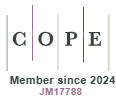Faricimab versus the standard of care for neovascular age-related macular degeneration in Italy: an indirect treatment comparison
DOI:
https://doi.org/10.33393/dti.2024.3213Keywords:
Faricimab, Indirect treatment comparison, nAMD, Vascular endothelial growth factor AAbstract
Objectives: To assess through an indirect treatment comparison (ITC) the potential benefit of faricimab over the anti-vascular endothelial growth factor (VEGF) real-life scenario, hereby defined standard of care (SoC), in Italy, that is, aflibercept, bevacizumab, and ranibizumab, in patients with neovascular age-related macular degeneration (nAMD) naïve to any anti-VEGF treatment.
Methods: Individual patient-level data from the phase III clinical trials TENAYA and LUCERNE (faricimab cohort) and the real-world study RADIANCE (RADIANCE cohort) were used. Efficacy was evaluated with changes in best corrected visual acuity (BCVA) and central subfield thickness (CST) from baseline to 1 year (week 52 in the RADIANCE and week 48 in the faricimab cohorts, respectively). Propensity score-based inverse probability of treatment weighting was utilized to balance cohorts and mitigate bias due to potential confounding. Sensitivity analyses were performed to evaluate treatment differences adjusted for the number of injections.
Results: The ITC included 513 patients treated with faricimab and 263 patients treated with SoC. At 1 year, faricimab showed a greater mean BCVA gain (treatment difference +5.4 letters, p<0.001) and CST reduction (treatment difference −71.8 μm, p<0.001) compared to SoC. Sensitivity analyses confirmed the robustness of results, showing a BCVA improvement of +4.0 letters and a CST reduction of −71.5 μm in favor of faricimab.
Conclusions: Despite the limitations due to the use of ITC and the comparison between clinical trials and real-world cohorts, the present analysis suggests potential benefits in terms of vision gain and CST reduction in naïve nAMD patients treated with faricimab compared with SoC in a real-world setting.
References
- Colijn JM, Buitendijk GHS, Prokofyeva E, et al; EYE-RISK consortium; European Eye Epidemiology (E3) consortium. Prevalence of age-related macular degeneration in Europe: the past and the future. Ophthalmology. 2017;124(12):1753-1763. https://doi.org/10.1016/j.ophtha.2017.05.035 PMID:28712657 DOI: https://doi.org/10.1016/j.ophtha.2017.05.035
- Flaxman SR, Bourne RRA, Resnikoff S, et al; Vision Loss Expert Group of the Global Burden of Disease Study. Global causes of blindness and distance vision impairment 1990-2020: a systematic review and meta-analysis. Lancet Glob Health. 2017;5(12):e1221-e1234. https://doi.org/10.1016/S2214-109X(17)30393-5 PMID:29032195 DOI: https://doi.org/10.1016/S2214-109X(17)30393-5
- Steinmetz JD, Bourne RRA, Briant PS, et al; GBD 2019 Blindness and Vision Impairment Collaborators; Vision Loss Expert Group of the Global Burden of Disease Study. Causes of blindness and vision impairment in 2020 and trends over 30 years, and prevalence of avoidable blindness in relation to VISION 2020: the Right to Sight: an analysis for the Global Burden of Disease Study. Lancet Glob Health. 2021;9(2):e144-e160. https://doi.org/10.1016/S2214-109X(20)30489-7 PMID:33275949 DOI: https://doi.org/10.1016/S2214-109X(20)30489-7
- Ambati J, Fowler BJ. Mechanisms of age-related macular degeneration. Neuron. 2012;75(1):26-39. https://doi.org/10.1016/j.neuron.2012.06.018 PMID:22794258 DOI: https://doi.org/10.1016/j.neuron.2012.06.018
- Cheung LK, Eaton A. Age-related macular degeneration. Pharmacotherapy. 2013;33(8):838-855. https://doi.org/10.1002/phar.1264 PMID:23580402 DOI: https://doi.org/10.1002/phar.1264
- Ferris FL III, Wilkinson CP, Bird A, et al; Beckman Initiative for Macular Research Classification Committee. Clinical classification of age-related macular degeneration. Ophthalmology. 2013;120(4):844-851. https://doi.org/10.1016/j.ophtha.2012.10.036 PMID:23332590 DOI: https://doi.org/10.1016/j.ophtha.2012.10.036
- Gheorghe A, Mahdi L, Musat O. Age-related macular degeneration. Rom J Ophthalmol. 2015;59(2):74-77. PMID:26978865
- Patel P, Sheth V. New and innovative treatments for neovascular age-related macular degeneration (nAMD). J Clin Med. 2021;10(11):2436. https://doi.org/10.3390/jcm10112436 PMID:34070899 DOI: https://doi.org/10.3390/jcm10112436
- Brown DM, Kaiser PK, Michels M, et al; ANCHOR Study Group. Ranibizumab versus verteporfin for neovascular age-related macular degeneration. N Engl J Med. 2006;355(14):1432-1444. https://doi.org/10.1056/NEJMoa062655 PMID:17021319 DOI: https://doi.org/10.1056/NEJMoa062655
- Busbee BG, Ho AC, Brown DM, et al; HARBOR Study Group. Twelve-month efficacy and safety of 0.5 mg or 2.0 mg ranibizumab in patients with subfoveal neovascular age-related macular degeneration. Ophthalmology. 2013;120(5):1046-1056. https://doi.org/10.1016/j.ophtha.2012.10.014 PMID:23352196 DOI: https://doi.org/10.1016/j.ophtha.2012.10.014
- Cohen SY, Mimoun G, Oubraham H, et al; LUMIERE Study Group. Changes in visual acuity in patients with wet age-related macular degeneration treated with intravitreal ranibizumab in daily clinical practice: the LUMIERE study. Retina. 2013;33(3):474-481. https://doi.org/10.1097/IAE.0b013e31827b6324 PMID:23266880 DOI: https://doi.org/10.1097/IAE.0b013e31827b6324
- Dugel PU, Koh A, Ogura Y, et al; HAWK and HARRIER Study Investigators. HAWK and HARRIER: phase 3, multicenter, randomized, double-masked trials of brolucizumab for neovascular age-related macular degeneration. Ophthalmology. 2020;127(1):72-84. https://doi.org/10.1016/j.ophtha.2019.04.017 PMID:30986442 DOI: https://doi.org/10.1016/j.ophtha.2019.04.017
- Heier JS, Brown DM, Chong V, et al; VIEW 1 and VIEW 2 Study Groups. Intravitreal aflibercept (VEGF trap-eye) in wet age-related macular degeneration. Ophthalmology. 2012;119(12):2537-2548. https://doi.org/10.1016/j.ophtha.2012.09.006 PMID:23084240 DOI: https://doi.org/10.1016/j.ophtha.2012.09.006
- Holz FG, Tadayoni R, Beatty S, et al. Multi-country real-life experience of anti-vascular endothelial growth factor therapy for wet age-related macular degeneration. Br J Ophthalmol. 2015;99(2):220-226. https://doi.org/10.1136/bjophthalmol-2014-305327 PMID:25193672 DOI: https://doi.org/10.1136/bjophthalmol-2014-305327
- Rosenfeld PJ, Brown DM, Heier JS, et al; MARINA Study Group. Ranibizumab for neovascular age-related macular degeneration. N Engl J Med. 2006;355(14):1419-1431. https://doi.org/10.1056/NEJMoa054481 PMID:17021318 DOI: https://doi.org/10.1056/NEJMoa054481
- Staurenghi G, Bandello F, Viola F, et al. Effectiveness of anti-vascular endothelial growth factors in neovascular age-related macular degeneration and variables associated with visual acuity outcomes: results from the EAGLE study. Khetan V, ed. PLoS One. 2021;16(9):e0256461. https://doi.org/10.1371/journal.pone.0256461 PMID: 34469431 DOI: https://doi.org/10.1371/journal.pone.0256461
- Martin DF, Maguire MG, Ying GS, Grunwald JE, Fine SL, Jaffe GJ; CATT Research Group. Ranibizumab and bevacizumab for neovascular age-related macular degeneration. N Engl J Med. 2011;364(20):1897-1908. https://doi.org/10.1056/NEJMoa1102673 PMID:21526923 DOI: https://doi.org/10.1056/NEJMoa1102673
- Calabria S, Ronconi G, Dondi L, et al. La popolazione con degenerazione maculare neovascolare correlata all’età trattata con anti-Vegf attraverso i dati amministrativi sanitari. Recenti Prog Med. 2023;114(7):447-461. PMID:37392108
- Kodjikian L, Mehanna CJ, Cohen SY, et al. The role of future treatments in the management of neovascular age-related macular degeneration in Europe. Eur J Ophthalmol. 2021;31(5):2179-2188. https://doi.org/10.1177/11206721211018348 PMID:34053331 DOI: https://doi.org/10.1177/11206721211018348
- Lanzetta P. Anti-VEGF therapies for age-related macular degeneration: a powerful tactical gear or a blunt weapon? The choice is ours. Graefes Arch Clin Exp Ophthalmol. 2021;259(12):3561-3567. https://doi.org/10.1007/s00417-021-05451-2 PMID:34669026 DOI: https://doi.org/10.1007/s00417-021-05451-2
- Daien V, Finger RP, Talks JS, et al. Evolution of treatment paradigms in neovascular age-related macular degeneration: a review of real-world evidence. Br J Ophthalmol. 2021;105(11):1475-1479. https://doi.org/10.1136/bjophthalmol-2020-317434 PMID:33130553 DOI: https://doi.org/10.1136/bjophthalmol-2020-317434
- Kertes PJ, Galic IJ, Greve M, et al. Efficacy of a treat-and-extend regimen with ranibizumab in patients with neovascular age-related macular disease: a randomized clinical trial. JAMA Ophthalmol. 2020;138(3):244-250. https://doi.org/10.1001/jamaophthalmol.2019.5540 PMID:31917441 DOI: https://doi.org/10.1001/jamaophthalmol.2019.5540
- Kim LN, Mehta H, Barthelmes D, Nguyen V, Gillies MC. Metaanalysis of real-world outcomes of intravitreal ranibizumab for the treatment of neovascular age-related macular degeneration. Retina. 2016;36(8):1418-1431. https://doi.org/10.1097/IAE.0000000000001142 PMID:27388744 DOI: https://doi.org/10.1097/IAE.0000000000001142
- Okada M, Kandasamy R, Chong EW, McGuiness M, Guymer RH. The treat-and-extend injection regimen versus alternate dosing strategies in age-related macular degeneration: a systematic review and meta-analysis. Am J Ophthalmol. 2018;192:184-197. https://doi.org/10.1016/j.ajo.2018.05.026 PMID:29885297 DOI: https://doi.org/10.1016/j.ajo.2018.05.026
- Silva R, Berta A, Larsen M, Macfadden W, Feller C, Monés J; TREND Study Group. Treat-and-extend versus monthly regimen in neovascular age-related macular degeneration: results with ranibizumab from the TREND study. Ophthalmology. 2018;125(1):57-65. https://doi.org/10.1016/j.ophtha.2017.07.014 PMID:28893454 DOI: https://doi.org/10.1016/j.ophtha.2017.07.014
- Wykoff CC, Clark WL, Nielsen JS, Brill JV, Greene LS, Heggen CL. Optimizing anti-VEGF treatment outcomes for patients with neovascular age-related macular degeneration. JMCP. 2018;24(2-a Suppl):S3-S15. https://doi.org/10.18553/jmcp.2018.24.2-a.s3 PMID: 29383980 DOI: https://doi.org/10.18553/jmcp.2018.24.2-a.s3
- AIFA. Determina 2 Ottobre 2023 Riclassificazione Del Medicinale per Uso Umano «Vabysmo», Ai Sensi Dell’articolo 8, Comma 10, Della Legge 24 Dicembre 1993, n. 537. (Determina n. 602/2023). (23A05528) (GU n.235 Del 7-10-2023). 2023. https://www.aifa.gov.it/documents/20142/961234/Determina_602-2023_Vabysmo.pdf.(Accessed July 2024).
- AIFA. Determina 28 Dicembre 2020 Istituzione Della Nota AIFA 98 Relativa Alla Prescrizione e Alla Somministrazione Intravitreale Di Anti-VEGF Nella AMD e DME. (Determina n. DG/1379/2020). (20A07338) (GU n.323 Del 31-12-2020). 2020. https://www.aifa.gov.it/documents/20142/1728119/Determina_28-12-2020_nota98.pdf.(Accessed July 2024).
- AIFA. Determina 30 Gennaio 2015 Inserimento Di Una Indicazione Terapeutica Del Medicinale per Uso Umano «Bevacizumab - Avastin» Nell’elenco Ex Lege n. 648/1996 - Parziale Modifica Alla Determina n. 622 DG/2014 Del 23 Giugno 2014 e Sostituzione Della Stessa. (Determina n. 79/2015). (15A01013) (GU n.38 Del 16-2-2015). 2015. Online https://www.aifa.gov.it/documents/20142/241028/Avastin_AMD_648_79_2015.pdf.(Accessed July 2024).
- Heier JS, Khanani AM, Quezada Ruiz C, et al; TENAYA and LUCERNE Investigators. Efficacy, durability, and safety of intravitreal faricimab up to every 16 weeks for neovascular age-related macular degeneration (TENAYA and LUCERNE): two randomised, double-masked, phase 3, non-inferiority trials. Lancet. 2022;399(10326):729-740. https://doi.org/10.1016/S0140-6736(22)00010-1 PMID:35085502 DOI: https://doi.org/10.1016/S0140-6736(22)00010-1
- Parravano MC, Viola F, Nicolo M, et al. Real-world evidence of anti-VEGF therapies in neovascular age-related macular degeneration in Italy: the RADIANCE study. Eur J Ophthalmol. (In Press)
- Chesnaye NC, Stel VS, Tripepi G, et al. An introduction to inverse probability of treatment weighting in observational research. Clin Kidney J. 2021;15(1):14-20. https://doi.org/10.1093/ckj/sfab158 PMID:35035932 DOI: https://doi.org/10.1093/ckj/sfab158
- Holz FG, Tadayoni R, Beatty S, et al. Determinants of visual acuity outcomes in eyes with neovascular AMD treated with anti-VEGF agents: an instrumental variable analysis of the AURA study. Eye (Lond). 2016;30(8):1063-1071. https://doi.org/10.1038/eye.2016.90 PMID:27197868 DOI: https://doi.org/10.1038/eye.2016.90
- Li JQ, Welchowski T, Schmid M, Mauschitz MM, Holz FG, Finger RP. Prevalence and incidence of age-related macular degeneration in Europe: a systematic review and meta-analysis. Br J Ophthalmol. 2020;104(8):1077-1084. https://doi.org/10.1136/bjophthalmol-2019-314422 PMID:31712255 DOI: https://doi.org/10.1136/bjophthalmol-2019-314422
- Pina Marín B, Gajate Paniagua NM, Gómez-Baldó L, Gallego-Pinazo R. Burden of disease assessment in patients with neovascular age-related macular degeneration in Spain: results of the AMD-MANAGE study. Eur J Ophthalmol. 2022;32(1):385-394. https://doi.org/10.1177/11206721211001716 PMID:33719641 DOI: https://doi.org/10.1177/11206721211001716










